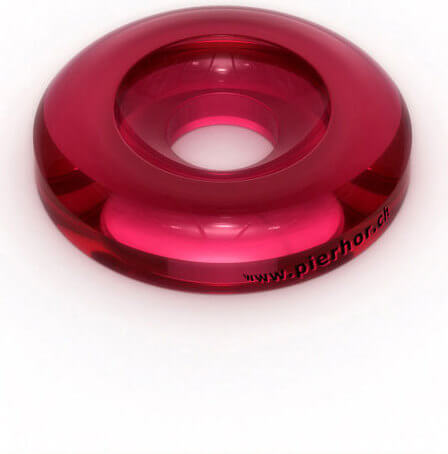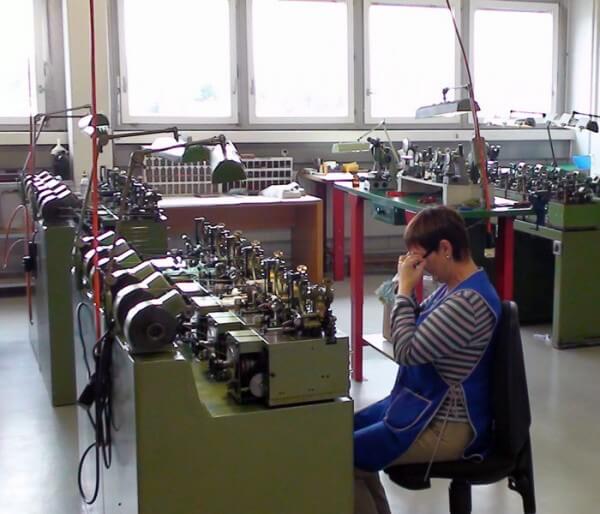Watch movements certainly wouldn’t be what they are today without synthetic jewels. Using a method developed in 1902 by Auguste Verneuil, aluminium oxide is heated, fused and crystallised, and chromium oxide added to give the red colour of ruby, to produce synthetic corundum. Prior to Verneuil’s invention, and thanks to diamond-wire drilling techniques developed in the early eighteenth century, watchmakers were already using spinel or garnet in their movements instead of the usual brass sinks. The introduction of synthetic ruby was a huge step forward, firstly because of its lower cost and secondly for its physical properties.
Synthetic ruby is a very hard stone (9 on the Mohs scale, the hardest mineral after diamond), extremely resistant to wear and, because of its homogenous structure, has a low friction coefficient. These properties are of particular interest to mechanical watchmaking as a means of significantly increasing a movement’s precision and lifespan. Synthetic ruby is also non-conducting, acid-resistant and unaffected by temperature change. All of which explains why the number of jewels – 12 to 60 depending on the movement – was for a long time engraved on the watch case as a sign of quality.

Securing supplies
Synthetic rubies have proven indispensable to the profession and, understandably, the leading firms have all looked for ways to secure supplies: the Swatch Group owns Comadur; Jaeger-LeCoultre, Patek Philippe and Rolex each holds a stake in La Pierrette, based in Le Brassus. A handful of independent businesses have nonetheless carved out a place in the market, including family-run Gasser-Ravussin, the French company Cheval Frères (Groupe IMI), and Pierhor, established in 1899 and taken over by François Durafourg in 1994. “I come from a family of stone-cutters for jewellery, from Saint Claude in the Jura,” he explains. “As soon as Verneuil made production possible, my grandfather invented a machine to cut synthetic stones. I was already involved in the watch sector when I heard Pierhor was up for sale, so I didn’t hesitate.”
Since taking over at the head of the firm, which also specialises in machining hard metals, François Durafourg has concentrated on diversifying Pierhor’s clientele and its products, with its sights clearly trained on Fine Watchmaking. The Poinçon de Genève, for example, states that “the movement’s gear-train and its escapement must have ruby jewels set in polished holes. Jewels on the bridge side must be olive-drilled and their sinks polished.” “We have become a reference in the business since opening up to the Poinçon de Genève, so much so in fact that we now supply virtually everyone except ETA, Patek Philippe and Jaeger-LeCoultre. Even Rolex is a major customer,” says François Durafourg. “Of course, this means there can be no cutting corners on quality. We guarantee our jewels to the micron and measure them using apparatus that is precise to one-tenth of a micron.” Pierhor also works with other varieties of corundum, including transparent and blue sapphire, blue spinel and zirconium oxide, which has the particularity of being self-lubricating. One product, however, is deliberately absent from Pierhor’s catalogue: sintered corundum which is moulded like ceramic and more suited to quartz movements as the holes tend to splay under mechanical stress.

A concentrated market
As François Durafourg likes to say, “a movement is only ever as good as its weakest part. If one part should be lacking or present a defect, even if every other part is perfect the movement will take much longer to adjust. Pierhor has built expertise in angling jewels for setting and ensuring holes are perfectly concentric, which eliminates the need for adjustment.” Such a high standard of expertise explains, in part at least, why the Swiss synthetic ruby market is concentrated in so few hands: five companies account for around 90% of total annual production of 300 million jewels, sold from 10 centimes each. The biggest buyers are ETA, Rolex, Sellita, Soprod and Dubois Dépraz. The market for the raw material itself is similarly concentrated with just two companies – Djeva in Switzerland and Rubis des Alpes (RSA) in France – monopolising supply in Europe. Internationally, China is shaping up to be Swiss firms’ biggest competitor, with annual production of some 900 million jewels.
“Obviously we cannot dismiss China’s potential as a supplier, which is why we have no other choice than quality.” François Durafourg concludes. “Customers appreciate this but it also means we have had to integrate production under one roof and bring in CNC machines to complement the existing machine-tools which, though much older, are irreplaceable. I’ve also set up a company that produces the wire for cutting stones, an essential factor in our line of business. As you can see, high-precision cutting of jewels for watch movements is a full-time challenge.”



















